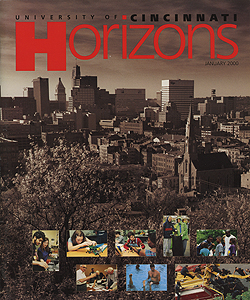An editorial reply
Let's look at the ratings

When "U.S. News and World Report" came out with its rankings on undergraduate colleges and universities last year, UC placed in the third of four tiers. At first glance, the third tier seemed embarrassing, especially when Xavier and Ohio universities ranked on higher tiers.
But the reality is: There are several lists, and UC made the most prestigious one, the "national" ranking. Only one-tenth of the country's four-year colleges and universities achieved that. Xavier University and other schools were eliminated from the more-restrictive listing of the top 10 percent, yet placed high on separate "regional" lists.
The same issue of the magazine did smile upon UC by including it on two other lists -- Best Business Programs and Best Undergraduate Engineering Schools in the country. And last spring, it ranked the College of Medicine 45th in the nation (with the pediatric program sixth and primary care 35th). It also placed the College of Law 47th and the paleontology PhD program ninth.
So how can the same university be the best in several areas and still fall in the lower half? One reason is that part of UC's mission is to provide the opportunity for a college education to a diverse student body.
That means we have four open-access colleges where anyone is welcome: Clermont College, Raymond Walters College, the College of Evening and Continuing Education and University College. There, if someone is willing to put their heart and soul into the effort, no one will debate entrance exams, graduation rates or maintaining minimum GPAs. Our latest advertising campaign said it best, "All Dreams Are Welcome Here."
Some UC colleges, of course, have stringent admission requirements and still remain highly selective. The College of Engineering, for example, offers admission to only 50 percent of its applicants. About half of those actually accept (25 percent of the total). The College-Conservatory of Music admitted 22 percent of its applicants this year.
The architecture program at the College of Design, Architecture, Art and Planning is so selective that the last incoming class had average ACT scores of 29.4 (compared to the national average of 21) and SAT scores of 1,315 (compared to the national average of 1,017). Eight percent of the class had been high school valedictorians.
But student statistics only compose part of the picture. Alumni giving is also a factor for "U.S. News."
While we would certainly appreciate higher levels of financial support from our alumni, we are proud that our endowments rank ninth largest in the nation. As far as grants are concerned, we are a Carnegie Commission Research I University with high levels of corporate and governmental support -- attracting $92.6 million in sponsored research last year alone. "U.S. News," however, considers only the alumni figures in determining its rankings.
Rankings routinely criticized
The bottom line is that ratings are controversial. According to the Council for Advancement and Support of Education, the higher-education community criticizes rankings as "unfair," "inaccurate" and containing "a bias against public universities." It's probably a good thing then that only 1 percent of high school students pay serious attention to rankings, as a UCLA study revealed.
The main problem with charts is that too many factors are involved. The Massachusetts Institute of Technology, for instance, grabbed the spot as the country's third best school, but also made the top 10 for having students graduate with the most debt. One could ask the question, "At what price is a high ranking worth it?"
Regardless of the debate, UC remains committed to attracting higher caliber students. To do that, we instituted the Cincinnatus Scholarship competition in the spring of '97.
Basically, any student in the top 5 percent ranking of a high school class, with a minimum 28 ACT score or 1,250 SAT score, can receive a $1,500 scholarship simply by participating in the competition. More than 1,000 students have competed each year, coming from 34 states and as far away as South Africa. Afterward, each was offered a scholarship, ranging from $1,500 to $60,000.
As a result, UC has seen an increase in average SAT scores among incoming freshmen since Cincinnatus began. In addition, the freshman class had a 43-percent increase in high school valedictorians in the first year alone.
Even though such signs look promising, the fact remains that we are in the third tier. And despite all arguments, no one is thrilled. Especially when Miami and Ohio State are in the second tier.
Alumnus Maurice Shigesato, Ed '51, was particularly distraught over the situation and wrote, "When I attended UC as an undergraduate student, I felt UC had given me the best they could offer academically, and I was able to function very well in my chosen profession .... UC certainly doesn't deserve such a poor rating." [See his original letter in our Letters department.]
We agree. Unfortunately, the issue is complex and the criteria for ratings do not always match our mission.
Related articles:
Letters to the Editor regarding this article (May 2000)
Response by editor regarding this article (May 2000)
Link:

 Past Issues
Past Issues